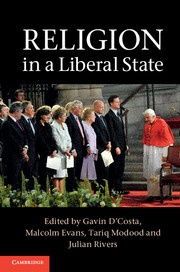Book contents
- Frontmatter
- Contents
- List of contributors
- Acknowledgements
- Introduction
- 1 Religion in a liberal state
- 2 The European Court of Human Rights and religious neutrality
- 3 Religion and sexual orientation: conflict or cohesion?
- 4 Liberal religion and illiberal secularism
- 5 Moderate secularism in liberal societies?
- 6 Excluded, included or foundational?
- 7 Justificatory secularism
- 8 What lacks is feeling: mediating reason and religion today
- 9 Arguing out of bounds: Christian eloquence and the end of Johannine liberalism
- Index
- References
2 - The European Court of Human Rights and religious neutrality
Published online by Cambridge University Press: 05 June 2014
- Frontmatter
- Contents
- List of contributors
- Acknowledgements
- Introduction
- 1 Religion in a liberal state
- 2 The European Court of Human Rights and religious neutrality
- 3 Religion and sexual orientation: conflict or cohesion?
- 4 Liberal religion and illiberal secularism
- 5 Moderate secularism in liberal societies?
- 6 Excluded, included or foundational?
- 7 Justificatory secularism
- 8 What lacks is feeling: mediating reason and religion today
- 9 Arguing out of bounds: Christian eloquence and the end of Johannine liberalism
- Index
- References
Summary
Introduction: the meanings of religious neutrality
It is often said that the state should be neutral in matters of religion, but neutrality is a problematic concept, capable of several different meanings. Despite that, the term is on the whole less problematic than ‘secular’. Several authors have noticed the differing senses of ‘secular’ when used in relation to the state (Taylor, 2009): from its original meaning denoting a division in jurisdiction between political and religious authorities (Benson, 2000) to official indifference (Rivers, 2010) or antipathy towards religion. Even in states such as France with constitutional provisions on secularity there can be considerable debate as to meaning (Laborde, 2008). Debates using the term ‘secular state’ are now so prone to terminological confusion that for the present purpose, in discussing the jurisprudence of the European Court of Human Rights (ECtHR), it is more helpful to focus on different aspects of neutrality.
Of these the least controversial perhaps is the duty of state officials to behave impartially, that is without judging between the merits of different religions and in a non-discriminatory way. Even this does not prevent controversy over whether there is scope for recognizing the religious beliefs of officials over matters of conscience in the workplace or whether to do so compromises the state’s position, as in Ladele v. London Borough of Islington (Malik, present volume). Beyond impartiality, however, conceptual controversy begins and at least four further variants can be identified, with different implications for both individuals and religious organizations. One strand stresses neutrality as the equi-distance of the state from all religions so they are treated even-handedly and none is favoured. This is often taken to entail separation of religion and state, although strictly it does not entail that. A second strand focuses on strict equality of treatment of religions by the state.
- Type
- Chapter
- Information
- Religion in a Liberal State , pp. 38 - 66Publisher: Cambridge University PressPrint publication year: 2013
References
- 1
- Cited by



